Fish Descriptions
So what is swimming around these waters in Monroe County you ask? See below for a list of current fish descriptions.
https://www.dec.ny.gov/outdoor/125040.html#Ontario
General Regulations
https://www.dec.ny.gov/outdoor/125040.html#General
 Largemouth Bass
Largemouth Bass
Largemouth bass have made a significant comeback to the Monroe County Region. The presence of the zebra mussel, along with stringent pollution controls, has contributed to very clear water conditions throughout the Great Lakes. The result is significant weed growth, giving the largemouth a place to grow and prosper. Largemouths are found in shallow, weedy areas of the bays and harbors lining the shores of Lake Ontario and throughout the regional Finger Lakes. Jigs, plastic worms and spinner baits work best. The state record is 11 pounds, 4 ounces with a spinner bait.
 Smallmouth Bass
Smallmouth Bass
Smallmouth bass are one reason so many fishermen come to Monroe County each year. Lake Ontario holds huge numbers of smallies and they grow to trophy size as well. Average catches of 20 to 50 fish a day are not unusual with fish in the 4 pound class not uncommon. Fish in the super-trophy 6 and 7 pound range show up each year as well. Minnows and crawfish work best for those who choose live bait. For artificial lures, tube jigs, grubs and other soft plastics work best. The state record is 8 pounds, 4 ounces with a jig & grub tail.
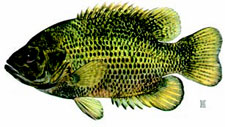 Rock Bass
Rock Bass
Often called “redeye,” rock bass can be caught spring, summer and fall throughout the Monroe County fishing area. Considered a panfish, they can be caught in relatively shallow waters under docks, under overhanging bushes or around any type of bottom structure. Worms, small spinners and wet flies seem to work best. The state record is 1 pound, 15 ounces with a live shiner.
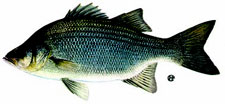 White Bass
White Bass
Also known as silver bass, white bass population numbers have dwindled a bit. However, they can still be caught with some regularity in the spring and fall by anglers using small silver spoons, spinners, small jigs tipped with twistertails and live bait like worms. The state record is 3 pounds, 6 ounces with a rattling crank bait.
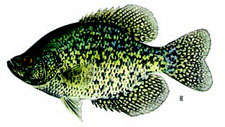 Crappie
Crappie
Sometimes referred to as Calico bass, these tasty panfish can be found in the shallows of Lake Ontario, the Genesee River and even in the Erie Canal. Both white and black crappie can be found in the Greater Monroe County Region with the best bait being a minnow placed two feet below a bobber. They will also hit small artificial lures. Best time of year to catch these fish is spring and fall. The state record for black crappie is 3 pounds, 12 ounces on a jig. The state record for white crappie is 3 pounds, 13 ounces with a jig.
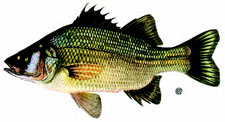 White Perch
White Perch
The white perch is a close relative of the white bass and striped bass. The most recognizable trait of this silvery fish is its purple throat. It differs from silver bass in that it has a dark back. Small worms are the best bait. They are usually found in six to eight feet of water near the bottom. The state record is 3 pounds, 1 ounce with an alewife.
 Yellow Perch
Yellow Perch
Yellow perch travel in schools so when you find one you’ll usually find more. These fish can be found in good numbers throughout the Monroe County Region, especially in Lake Ontario and the Genesee River. Spring and fall are the best times to catch these fish with minnows and red worms as the best baits. The state record is 3 pounds, 8 ounces with a minnow.
 Walleye
Walleye
Walleye is one of the most popular sport fish anywhere. They grow big and are available in the Monroe County Region. The best baits are spinners and worms for drifting and slow trolling. For speed trolling, stick baits and worm harnesses attached to Dipsy Divers and side planers/planer boards work best. A jig tipped with a night crawler is also an excellent bait to throw. The state record is 16 pounds, 7 ounces with a twister on a jig
 Northern Pike
Northern Pike
Northern pike are among New York State’s most important game fish and can be found with frequency throughout the Monroe County area. They are relatively easy to catch and put up a great fight when hooked. Northerns prefer weedy portions of rivers, ponds, and lakes, but large adults will often move offshore into deeper waters. Some of the weedy areas around the bays and harbors of Lake Ontario and the drainages of regional Finger Lakes offer good opportunity to catch these toothy sport fish. Also there are great angling opportunities for Northerns on the Erie Canal, especially in the spring off feeder creeks. Northerns can be taken through the ice as well as in open water, and provide an important winter fishery. Ice derbies are common sporting events for these prize fish in many parts of the State. Northern pike spawn in April or May, normally just after ice-out. Like other pike, they migrate into flooded marshes to deposit their adhesive eggs. A chub fished under a bobber is a favorite shore fishing technique. Other popular baits include spinner baits, spoons, stick baits — anything with flash. Fish exceeding 20 pounds have been caught in local waters. The state record is 46 pounds, 2 ounces with a flaptail stick bait
 Muskellunge
Muskellunge
The largest member of the pike family, the muskellunge, or musky, is also the largest freshwater game fish in New York State. It often grows to more than 40 pounds. Muskellunge have similar spawning habits to other pike, spawning in mid to late spring. Muskies generally spawn slightly later than northern pike, and in waters where the two species occur together, later spawning puts them at a disadvantage. The earlier-hatching young northerns will eat young muskellunge. Because of their large size and rarity, muskellunge are held in high regard. Their unpredictable nature fascinates people. It can take an experienced musky angler as much as 50 hours of fishing to catch one of these giants. A large musky has tremendous strength and may take up to one hour to land. Although muskellunge are tasty, most anglers now practice “catch and release” to help ensure the future of limited populations. Giant baits trolled with wire line or fire line work best, but an increasing number of anglers are casting the outside of weed beds to target these fish. The state record is 69 pounds, 15 ounces
 Atlantic Salmon
Atlantic Salmon
This species was once indigenous to New York. Catching an Atlantic salmon is a rare feat, but once you catch one you’ll remember it for a lifetime. Lake Ontario is the only water in the Monroe County area currently receiving stockings, with occasional fish showing up in the Genesee River and some of the tributaries. These fish are often confused with brown trout for identification. In an effort to protect them, the minimum size for these fish is 25 inches. The state record is 24 pounds, 15 ounces with a long crank bait
 Chinook Salmon
Chinook Salmon
The king salmon is one of the most sought after trophies on Lake Ontario. They can be caught from April through November, with one of the best times being April and May. During the Spring Lake Ontario Counties Derby, more than 50 percent of all winning fish are traditionally caught from these waters. August and September are also good months in the lake from the Genesee River to east and west points on the shoreline. This is when these fish will move into the river and tributaries in an attempt to spawn. The state record fish is 47 pounds, 13 ounces with an orange fly
 Coho Salmon
Coho Salmon
This cousin of the Chinook normally doesn’t get as big as the king. However, with the world record catch coming from Lake Ontario at 33 pounds, 7 ounces, you might get an argument from some. Coho show up in the spring and stay in the area into the fall when they follow the kings in to spawn. Currently, only Lake Ontario receives stockings of these fish, but an occasional fish will show up in tributaries. These are popular fish to target with spoons and spinners off the shoreline of the Genesee River during the spring when waters are just starting to warm.
 Brown Trout
Brown Trout
Most of the brown trout fishing takes place in Lake Ontario. Browns can be found throughout the year in Lake Ontario or its tributaries, and the lower Genesee River during fall and winter. Come springtime, the big lake is the best spot, trolling the shoreline during April and May. July and August are good times to target browns out a bit deeper, but inside of 100 foot depths. Placing small spoons on or near the bottom near the thermocline is traditionally the best approach. Fish over 30 pounds have been caught. The state record is 33 pounds, two ounces from Lake Ontario with a stick bait.
 Lake Trout
Lake Trout
Lake trout are part of a Federal restoration effort. Each year, New York’s portion of Lake Ontario receives around 620,000 fish. Lake trout abound in the Monroe County Region for a number of reasons. In Lake Ontario, some of the deepest and coldest waters afford good angling opportunity for trollers working deep water shoals and reefs with spoons and stickbaits. May through August is the best time. One fish is the limit on this lake, the same body of water the state record comes from at 41 pounds, eight ounces. In the winter and early spring, lake trout actually run up into the Genesee River and are easily accessible from both boat and shore. Out in the lake, these trout can be caught from January until September 30th when the season closes. Average size in the river and out in the lake is 10 to 14 pounds. In all of these lake trout waters, you’ve got an excellent chance at catching a 20-pound trophy, with an outside chance at a 30- pound fish!
 Rainbow/Steelhead Trout
Rainbow/Steelhead Trout
The rainbow/steelhead trout are popular targets and can be caught throughout the year in Monroe County waters. These fish can be caught in the tributaries from September through May, depending on water temperatures. During the remaining months, they can be caught in Lake Ontario by targeting thermal structure in preferred temperature zones. Spoons and stickbaits are the most popular baits for trollers; drifters and casters like using egg sacks, egg imitation baits or live bait like worms or minnows. The top steelhead fishery in Monroe County is the lower Genesee River. However, all streams with decent water flow will attract these fish.
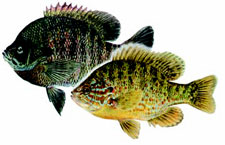 BlueGill/Pumpkinseed
BlueGill/Pumpkinseed
Bluegills are generally found in slow moving or standing water where there is plenty of vegetation or other shelter. They live in a wide range of habitats from small lakes and ponds to shallow, weedy bays of larger lakes and quiet waters of slow moving streams. The large, square-shaped, blue-black gill flap and conspicuous dark blotch on the back of the soft-rayed portion of their dorsal fins distinguishes bluegills from their close relatives, the pumpkinseed. Bluegills average four to ten inches in length. Like other true sunfish, the bluegill eats mostly insects and crustaceans. But unlike its cousins, the bluegill will also consume some plant material. Bluegills spawn from May to July. Nests are usually built close to shore in firm sand or mud in two and one-half feet of water. Bluegills often nest in colonies with nests sometimes right next to each other. Bluegills fight hard when hooked, providing good sport for anglers. They bite just about any bait, artificial fly, or small lure dropped in the water. Because of these qualities, they are frequently stocked in farm ponds and other impoundments. All are usually easy to catch, good to eat, and extremely popular with anglers, especially children. The bluegill state record is 2 pounds, 8 ounces with a worm, and the pumpkinseed record is 1 pound, 9 ounces with a night crawler.
 Bullhead
Bullhead
These fish can be found throughout the Monroe County area, with spring being the most popular time for catching these tasty fish. Beware of the sharp spines on the dorsal and pectoral fins. Worms, crabs and minnows are all favorite foods of whiskered fish, but stink bait, chunks of meat or dough balls can all be used to catch these fish, too. The state record for brown bullhead is 6 pounds, 9 ounces and the black bullhead record is 7 pounds, 7 ounces. Both were caught with night crawlers.
 Channel Catfish
Channel Catfish
These fish are really making a mark on the regional fishing scene, with a state record fish of 32 pounds, 12 ounces. These fish can be consistently caught from May to October throughout Great Lakes waters.
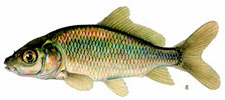 Carp
Carp
Carp are quickly gaining recognition as a prized catch in Monroe County waters, especially since European anglers started coming over to sample our fishery. The result has been some impressive catches, including some fish over 40 pounds. The state record is 50 pounds, 4 ounces. Carp can be found in most streams, the shallow bays off Lake Ontario, and throughout the Erie Canal system. Worms are a favorite bait, as is corn, dough balls or bread.
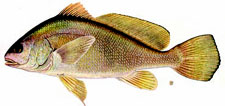 Sheepshead
Sheepshead
The sheepshead or freshwater drum is the only member of the drum family that lives entirely in freshwater in North America. They are quite common throughout the Great Lakes of Western New York and usually put up a good fight. The ear bones in the head of the fish have long been considered “lucky stones.” Average size is about 15 inches long, but they do get much bigger. The state record catch is currently 24 pounds, 7 ounces.
 Suckers
Suckers
These fish can be found in most every stream flowing into Lake Ontario come spring and early summer. Spearing was once a legal method for taking these fish in the tributaries, but that option is no longer available to anglers. Instead, try fishing with dew worms at night. The record for a white sucker is 5 pounds, 3 ounces with a night crawler. The record for a redhorse sucker is 11 pounds, 11 ounces with a night crawler.
 Smelt
Smelt
Rainbow smelt are popular forage fish in the Great Lakes. Lake Ontario supports populations of these baitfish, mostly accessible in the spring when they attempt to run up feeder streams to spawn. Long handled dip nets are used at night to catch these fish.
 Sturgeon
Sturgeon
There are many species of sturgeon, but the one that’s indigenous to this area is the lake sturgeon. Considered a threatened species in this state, this living fossil has been making a comeback in parts of Lake Ontario. These fish are easily identifiable by the sharp bony plates along their back and sides and by their long pointed snout. Lake sturgeon can grow to lengths of over six feet, weigh in excess of 200 pounds and live to be more than 100 years old. It is illegal to possess these fish.
 Round Goby
Round Goby
These small exotic invaders spell bad news for the local fish communities. Introduced into the Great Lakes through illegal ship ballast exchanges in the past decade, population levels have exploded and they are starting to displace native species of fish. If you catch a round goby, kill it.
Fishing Brochure
Live Interactive Map
Hot Spot Map

